Prior to 16th century
| History of Iraq |
|---|
 |
- 638 CE - Military camp established by Utbah ibn Ghazwan per order of Omar ibn al-Khattab. [1]
- 646 - Abdallah ibn Amer becomes governor. [2]
- 658 - Battle of the Camel. [1]
- 664 - Ziyad ibn Abihi becomes governor. [2]
- 673 - Ubayd Allah ibn Ziyad becomes governor.
- 683 - Uprising against Umayyads. [1]
- 684 - The governor Mas'ud ibn Amr is killed by the asāwira under Māh-Afrīdūn [3] [4]
- 691 - Abd al-Malik ibn Marwan in power.
- 701 - Uprising against the Umayyads. [1]
- 772 - Ramparts built. [5]
- 820 - Zott conflict. [6]
- 868 - Zanj Rebellion. [1]
- 871 - City sacked during Zanj Rebellion. [1]
- 923 - Qaramitah conflict. [6]
- 10th century - Public library active. [7]
- 1052 - Traveller Nasir Khusraw visits city. [7]
- 1122 - Imad ad-Din Zengi in power.
- 1123 - City wall rebuilt. [7]
- 1258 - City sacked by Mongols. [5]
- 1327 - Traveller Ibn Battuta visits city. [1]
- 1411 - Kara Koyunlu in power.
